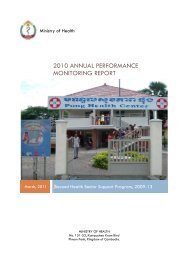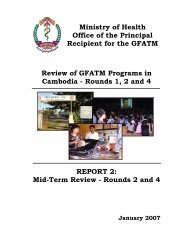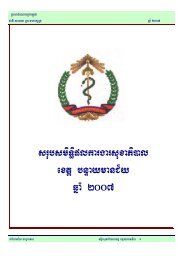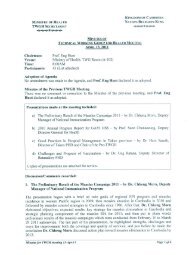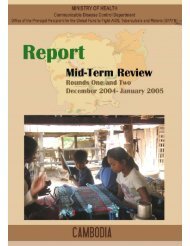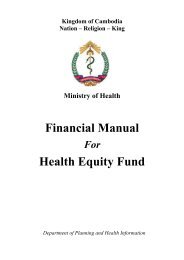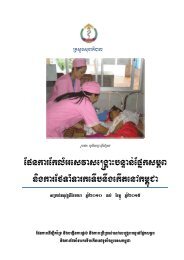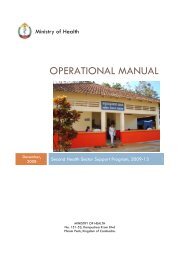Joint Annual Performance Review 2007 - Ministry of Health
Joint Annual Performance Review 2007 - Ministry of Health
Joint Annual Performance Review 2007 - Ministry of Health
Create successful ePaper yourself
Turn your PDF publications into a flip-book with our unique Google optimized e-Paper software.
Opening Remarks by<br />
Dr Michael J. O’Leary, WHO Representative<br />
on behalf <strong>of</strong> <strong>Health</strong> Partners<br />
<strong>Joint</strong> <strong>Annual</strong> <strong>Performance</strong> <strong>Review</strong>,<br />
5 th March <strong>2007</strong><br />
Y.E. Keo Puthreasmey Deputy Prime Minister,<br />
Y.E. Nuth Sokhom, Minister <strong>of</strong> <strong>Health</strong>,<br />
Y.E. Secretaries <strong>of</strong> State for <strong>Health</strong>,<br />
Distinguished guests, colleagues, ladies and gentlemen<br />
I am honoured and very pleased to be here today to make a few remarks on behalf <strong>of</strong> the<br />
<strong>Health</strong> Partners, at this opening <strong>of</strong> the National <strong>Health</strong> Congress and <strong>Joint</strong> <strong>Annual</strong><br />
<strong>Performance</strong> <strong>Review</strong> <strong>2007</strong>.<br />
During 2006 the <strong>Ministry</strong> <strong>of</strong> <strong>Health</strong> has achieved good progress in addressing the many<br />
challenges it faces in the health sector. At last year’s JAPR, five priority areas were identified<br />
for the coming year, focusing especially on child survival and reproductive health. These are:<br />
• emergency obstetric care;<br />
• attendance at delivery by trained health providers;<br />
• implementation <strong>of</strong> the Child Survival Scorecard interventions;<br />
• full MPA status at health centers; and<br />
• reproductive health including birth spacing services.<br />
<strong>Joint</strong> Monitoring Indicators to track progress are concerned with:<br />
• the improved and timely disbursement <strong>of</strong> funds in the health sector;<br />
• greater access in the community to midwifery services;<br />
• skilled attendance at deliveries;<br />
• tracking <strong>of</strong> the numbers <strong>of</strong> health centers with full MPA status, and<br />
• the increased use <strong>of</strong> health facilities in the public sector by the population at large.<br />
The draft JAPR report indicates a number <strong>of</strong> clear achievements in these and other areas. For<br />
example, the use <strong>of</strong> health services and the attendance <strong>of</strong> public health staff at deliveries has<br />
increased; a wide range <strong>of</strong> behaviour change messages were made known through the media;<br />
and the timely release <strong>of</strong> funds from an increased budget has improved. The drafting <strong>of</strong> a<br />
Merit Based Pay Initiative, an Institutional Development Report, and a National Strategy for<br />
the Prevention and Control <strong>of</strong> Non-Communicable Disease; plus the finalization <strong>of</strong> the<br />
Guidelines for the Complementary Package <strong>of</strong> Activities are a few <strong>of</strong> many accomplishments<br />
that will contribute to further improvement <strong>of</strong> health sector performance.<br />
This progress is also reflected in the health status impact data that have been generated by the<br />
Cambodia Demographic and <strong>Health</strong> Survey, or CDHS 2005. For example, the results in the<br />
preliminary report showed antenatal clinic attendance almost doubled. The Total Fertility<br />
Rate is reduced. Preliminary un<strong>of</strong>ficial information from the final CDHS also suggests that<br />
HIV prevalence may have declined amongst adults 15-49 years <strong>of</strong> age. This shows what<br />
Cambodia can accomplish if the political will and financial and human resources are<br />
adequately mobilised by both government and development partners.<br />
Gains in child survival are especially encouraging, with a decrease <strong>of</strong> more than 30% in infant<br />
and under-five mortality. Two-thirds <strong>of</strong> children between 12 and 23 months <strong>of</strong> age are fully<br />
vaccinated, and 60% <strong>of</strong> children are exclusively breastfed during their first six months. Major<br />
- 91 -



